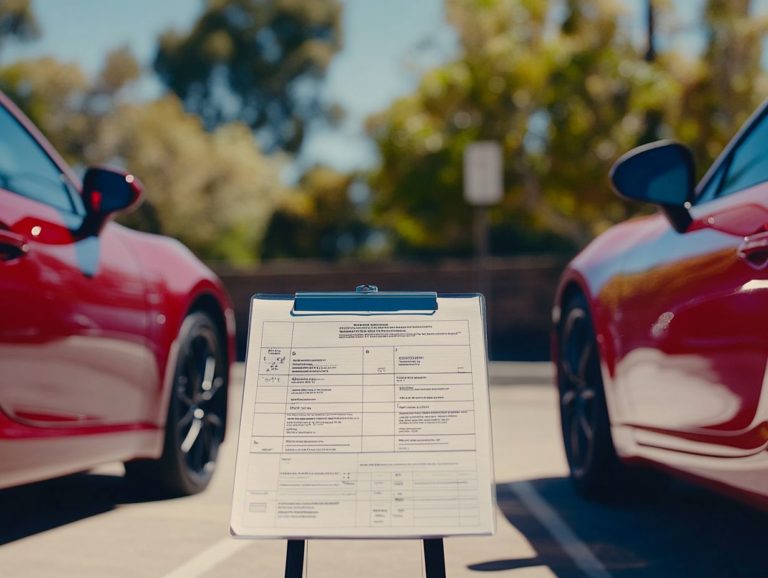Understanding Comparison Ratings for Cars
Choosing a car can feel overwhelming. Comparison ratings are valuable tools that help you navigate this process.
This article delves into the essence of comparison ratings, shedding light on the key features and performance metrics that demand your attention. You’ll discover how to interpret these ratings using a straightforward scoring system, allowing you to distinguish between expert opinions and consumer insights.
With practical tips at your disposal, you’ll be equipped to utilize this information effectively, ensuring that you find a car tailored to your needs. With the right comparison ratings, you’ll enjoy every drive!
Contents
- Key Takeaways:
- Factors to Consider in Comparison Ratings
- How to Interpret Comparison Ratings
- Types of Comparison Ratings
- Using Comparison Ratings to Make a Decision
- Frequently Asked Questions About Comparison Ratings
- Are comparison ratings for cars reliable?
- Do comparison ratings for cars take into account personal preferences?
- Where can I find comparison ratings for cars?
Key Takeaways:
- Comparison ratings provide a standardized way to assess and compare cars based on key features and performance metrics.
- Understanding the scoring system used in comparison ratings can help you make an informed decision when choosing a car.
- Expert ratings and consumer ratings offer different perspectives on cars, so it’s important to consider both when researching and comparing vehicles.
What are Comparison Ratings?
Comparison ratings help you evaluate a range of vehicles based on common standards. With insights from trusted sources like Consumer Reports, these ratings encompass essential factors such as reliability, safety, and owner satisfaction, enabling you to make informed decisions during your car-buying journey.
These ratings are more than just numbers; they provide critical information for safety-conscious buyers, offering a clearer picture of vehicle performance, comfort, fuel economy, and modern safety features. For example, when you delve into the world of SUVs, comparison ratings can illuminate differences in crash test results and driver-assist features, ensuring you select a model that perfectly matches your safety and comfort preferences.
Car experts utilize these ratings to deliver thorough assessments, detailing how vehicles perform under various conditions. They advise you on which options truly offer the best value for your investment. By synthesizing data from numerous tests, organizations like Consumer Reports enhance your buying experience, enabling you to navigate the complex automotive landscape with renewed confidence.
Factors to Consider in Comparison Ratings
When you evaluate Comparison Ratings, several key factors come into play that directly influence your overall assessment of a vehicle’s performance and its suitability for you.
These factors include reliability, safety ratings, and ownership costs. Each element plays a crucial role in ensuring that you make an informed decision that aligns with your expectations and lifestyle.
Key Features and Performance Metrics
Key features and performance metrics are essential components in your evaluation of vehicles, significantly impacting both your driving experience and overall satisfaction.
Take fuel economy, for example. It’s not just about saving money at the pump; it also plays a role in environmental considerations, making it a critical factor for you as a modern consumer.
Then there are modern safety features, which you’ll find increasingly highlighted in assessments from trusted sources like NHTSA and IIHS. These systems offer extra safety features, enhancing your peace of mind on the road.
Ratings from these organizations often serve as benchmarks, helping you make informed choices that reflect real-world performance and reliability.
Ultimately, the combination of these factors not only elevates your driving experience but also serves as a foundation for helping you make better choices, guiding you toward vehicles that perfectly align with your specific needs.
How to Interpret Comparison Ratings
To interpret comparison ratings effectively, you need to grasp how cars are rated by automotive experts and reputable consumer reports. This understanding will enable you to extract meaningful insights into vehicle performance, enabling you to make informed decisions.
Understanding the Scoring System
Understanding the scoring system of Comparison Ratings is key. It shows how metrics like safety ratings, reliability, and owner satisfaction are measured and presented.
This system provides a holistic view. It integrates aspects like safety performance, which checks how well vehicles protect occupants during crashes, and fuel economy, measuring fuel usage efficiency.
Advanced safety features, such as automatic emergency braking and lane-keeping assist, improve scores by showcasing a focus on innovation and driver safety.
Experts emphasize that these scores are crucial. They help you make informed choices as a consumer.
Consumer Reports provides insights on how to interpret these ratings. Higher scores often mean better vehicle quality, guiding you toward safer and more reliable options.
Types of Comparison Ratings
You’ll find different types of Comparison Ratings, each designed for unique purposes. Among these are expert ratings from trusted organizations like J.D. Power and consumer ratings that reflect real-world experiences.
Expert Ratings
Expert ratings give a professional perspective on vehicle quality and performance. They are essential as you navigate the automotive market.
Experts evaluate vehicles using various methods. They focus on aspects like crash-test data, driving experience, and safety system effectiveness.
Consumer ratings reflect everyday use, highlighting owner satisfaction and common issues that may not show up in professional reviews.
Using Comparison Ratings to Make a Decision
Using Comparison Ratings can significantly improve your vehicle choice process.
Tips for Finding the Right Car for You
Finding the right car means understanding your needs and using comparison ratings wisely.
Consider your personal preferences. Think about what makes you comfortable—like seat feel or cabin space.
Fuel economy is also crucial, especially for long drives. Focus on models with good fuel economy for savings.
Modern safety features, such as lane departure warnings and automatic emergency braking, greatly improve your driving peace of mind.
Explore detailed reports and user surveys for invaluable insights into real-world experiences and satisfaction levels that go beyond manufacturer specs.
Frequently Asked Questions About Comparison Ratings
What are car comparison ratings?
Car comparison ratings evaluate different vehicles based on criteria like performance, safety, and fuel efficiency. They help you make informed choices.
How are comparison ratings for cars determined?
Comparison ratings are determined by thorough tests of factors like acceleration, braking, handling, and safety features. They are compared with other cars in the same class.
Why should I pay attention to comparison ratings for cars?
Understanding comparison ratings for cars helps you make informed choices. They guide you in selecting a vehicle that fits your needs.
Are comparison ratings for cars reliable?
Comparison ratings for cars are generally reliable. They are based on thorough testing, but personal research is crucial before making a final decision.
Do comparison ratings for cars take into account personal preferences?
Comparison ratings focus on objective metrics. However, your priorities and preferences should also influence your choice.
Where can I find comparison ratings for cars?
You can find car comparison ratings on websites like Consumer Reports, Edmunds, and Kelley Blue Book. Reading reviews from trusted sources also helps you understand a vehicle’s performance and value.

.jpg_00.jpeg)
.jpg_01.jpeg)
.jpg_10.jpeg)
.jpg_11.jpeg)




